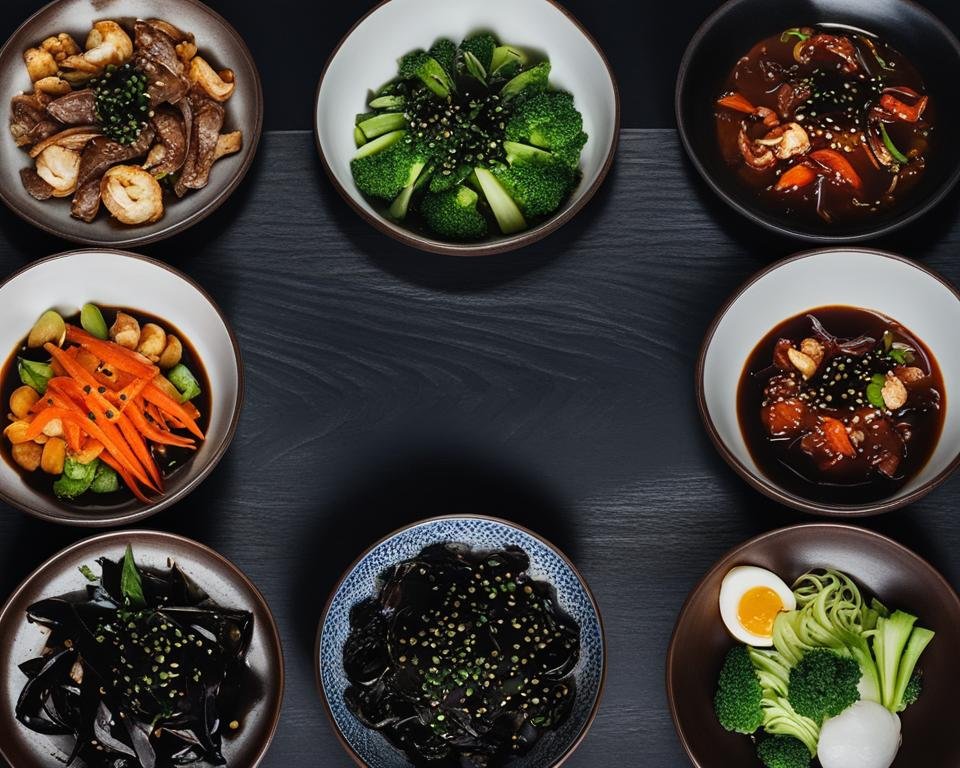When it comes to cooking with soy sauce, there are two main types that often take center stage: light soy sauce and dark soy sauce. These two varieties offer distinct flavors, colors, and culinary uses, adding depth and complexity to dishes. Understanding the difference between light and dark soy sauce can elevate your cooking and bring exciting new flavors to your meals.
Key Takeaways:
- Light soy sauce has a lighter color and milder flavor, making it ideal for seasoning dishes without overpowering them.
- Dark soy sauce has a deeper, richer color and stronger flavor, perfect for adding color and depth to marinades, stews, and braised meats.
- Choose between light and dark soy sauce depending on your desired flavor and color. Light soy sauce is more versatile, while dark soy sauce is great for recipes that require a robust flavor.
- Using a combination of light and dark soy sauce can create a balanced and harmonious flavor profile.
- Experiment with different recipes to explore the unique flavors each type of soy sauce offers.
Flavor Profile and Culinary Uses
When it comes to flavor and culinary uses, both light soy sauce and dark soy sauce bring their own unique qualities to dishes. Light soy sauce offers a milder, saltier flavor that enhances the overall taste without overpowering it. This makes it a versatile ingredient in a variety of dishes.
- In stir-fries, light soy sauce adds a savory umami taste and helps to season the ingredients evenly.
- When making soups, a splash of light soy sauce can help to enhance the depth of flavors.
- For dipping sauces, light soy sauce is a popular choice as it adds a savory kick and balances other flavors.
Light soy sauce can also be used as a seasoning for marinades and dressings, adding a touch of umami and saltiness to elevate the overall taste of the dish.
On the other hand, dark soy sauce has a more intense, savory, and slightly sweet flavor. It is commonly used in marinades to infuse meats, poultry, and seafood with a rich umami taste. Dark soy sauce is a staple ingredient in many Asian cuisines and is often used in:
- Braised dishes, where it adds depth of flavor and a dark, appetizing color to the sauce.
- Stews, where it contributes to the robustness of the dish and enhances the overall taste.
- Noodle dishes, where it offers a deep, savory flavor and a visually appealing dark hue to the dish.
By using light soy sauce and dark soy sauce judiciously, you can elevate the flavor profiles of your dishes and create a rich, satisfying culinary experience.
Choosing Between Light and Dark Soy Sauce
The choice between light and dark soy sauce largely depends on the desired flavor and color of the dish. Here’s a guide to help you decide which soy sauce to use:
Light Soy Sauce
Light soy sauce, also known as all-purpose soy sauce, is a versatile option that can be used in a wide range of recipes. It has a lighter color and a milder, saltier flavor compared to dark soy sauce. Light soy sauce is an excellent choice when you want to season a dish without altering its color or overpowering it with soy flavor. Some popular uses of light soy sauce include:
- Simple stir-fries
- Marinades for meat, poultry, and seafood
- Dressings for salads and vegetables
- Soups and broths
Light soy sauce adds a savory and umami taste to dishes, enhancing the overall flavor without being too overpowering.
Dark Soy Sauce
Dark soy sauce has a deeper, richer color and a stronger, saltier taste compared to light soy sauce. It is best suited for recipes that require a rich, deep color and robust flavor. Dark soy sauce is commonly used in the following types of dishes:
- Braised meats and vegetables
- Stews and casseroles
- Noodle dishes
- Marinades for meat, poultry, and seafood
Dark soy sauce adds complexity and depth of flavor to dishes, creating a satisfying and appetizing taste.
Choosing the Right Soy Sauce for Your Dish
When deciding between light and dark soy sauce, consider the overall flavor and color you want to achieve in your dish. If you prefer a milder taste and want to preserve the natural colors of the ingredients, opt for light soy sauce. On the other hand, if you’re looking to add a deep, rich flavor and enhance the visual appeal of your dish, dark soy sauce is the way to go.
In many cases, a combination of both light and dark soy sauce can be used to achieve a balanced and harmonious flavor. Experiment with different ratios to find the perfect blend for your recipes.
Remember to always taste and adjust the seasoning as you cook to ensure the flavors are well-balanced and enjoyable.
Now that you know the differences between light and dark soy sauce and how to choose between them, let’s explore some delicious recipes featuring these versatile condiments:
| Recipes with Light Soy Sauce | Recipes with Dark Soy Sauce |
|---|---|
| Stir-fried vegetables with light soy sauce | Braised soy sauce chicken |
| Steamed fish with light soy sauce | Beef and broccoli stir-fry |
| Marinated tofu with light soy sauce | Char siu pork |

Incorporate light and dark soy sauce into your cooking to add depth of flavor and enhance the taste of your dishes. Whether you’re making a simple stir-fry or a hearty braised meat dish, the right choice of soy sauce can elevate your culinary creations to new heights.
Conclusion
Light soy sauce and dark soy sauce are two essential ingredients in Asian cuisine that contribute unique flavors and culinary benefits to a wide variety of dishes. While light soy sauce is lighter in color and milder in taste, making it perfect for delicately seasoning dishes without overpowering them, dark soy sauce boasts a deeper color and stronger flavor, ideal for adding richness and depth to recipes.
Understanding the differences between light and dark soy sauce allows for greater creativity and versatility in the kitchen. Light soy sauce enhances the overall taste of a dish, while dark soy sauce adds color and a robust umami flavor. By incorporating both types into your cooking, you can achieve a harmonious balance of flavors and produce dishes that are visually appealing and delicious.
Whether you’re preparing a quick stir-fry, a hearty stew, or a flavorful marinade, both light and dark soy sauce have their own unique roles to play in elevating your culinary creations. Experiment with different combinations and quantities to find the perfect balance of flavors in your dishes, and let the magic of light and dark soy sauce bring your cooking to new heights.
FAQ
What is the difference between light and dark soy sauce?
The key difference between light and dark soy sauce lies in their flavor, color, and culinary uses. Light soy sauce has a lighter color and is less intense in flavor, while dark soy sauce has a deeper, richer color and a stronger, saltier taste.
What are the uses of light soy sauce?
Light soy sauce, also known as all-purpose soy sauce, is commonly used for seasoning dishes without overpowering them with soy flavor. It is ideal for stir-fries, soups, dipping sauces, and can even be used as a seasoning for marinades and dressings.
What are the uses of dark soy sauce?
Dark soy sauce is typically used to add color and flavor to dishes. It is commonly used in marinades, stews, braised meats, and noodle dishes to infuse them with a rich umami taste and a dark, appetizing color.
How can I cook with light soy sauce?
Light soy sauce is a versatile option that can be used in a wide range of recipes. It can be used to season stir-fries, soups, and dipping sauces, as well as to enhance the flavor of marinades and dressings.
How can I cook with dark soy sauce?
Dark soy sauce is best suited for recipes that require a rich, deep color and robust flavor. It is commonly used in braised dishes, stews, and recipes where the sauce itself plays a prominent role.
Are there any specific recipes that use light soy sauce?
Yes, light soy sauce can be used in a variety of recipes, including stir-fried vegetables, fried rice, vegetable soups, and dipping sauces.
Are there any specific recipes that use dark soy sauce?
Absolutely! Dark soy sauce can be used in recipes such as braised pork belly, soy sauce chicken, char siu (barbecue pork), and stir-fried noodles.
How do I choose between light and dark soy sauce?
The choice between light and dark soy sauce largely depends on the desired flavor and color of the dish. Light soy sauce is a versatile option that can be used in a wide range of recipes, while dark soy sauce is best suited for recipes that require a rich, deep color and robust flavor. In many cases, a combination of both light and dark soy sauce can be used to achieve a balanced and harmonious flavor.
What are the main takeaways about light and dark soy sauce?
Light soy sauce has a milder, saltier flavor and is used for seasoning, while dark soy sauce has a more intense, savory taste and is used for adding color and flavor to dishes. Both types of soy sauce offer distinct flavors and culinary benefits, allowing for greater creativity and versatility in the kitchen.



